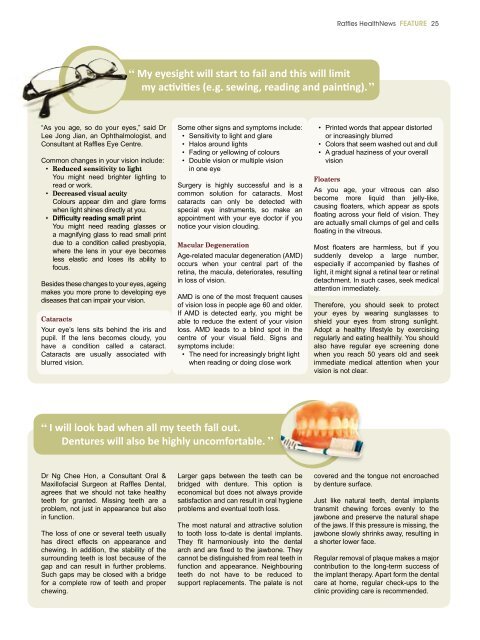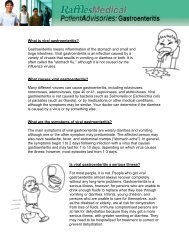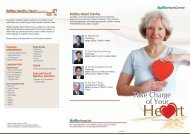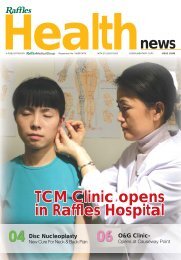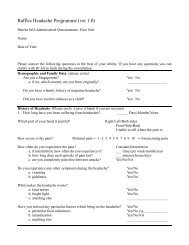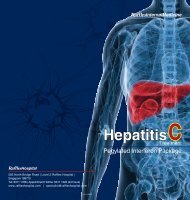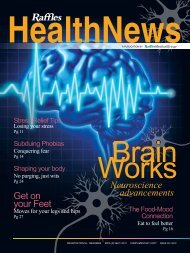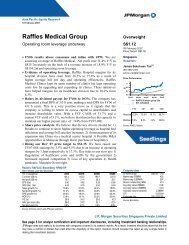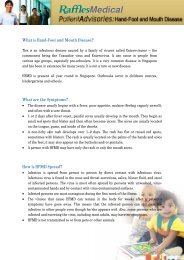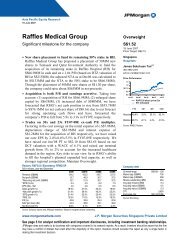Ageing Gracefully - Raffles Medical Group
Ageing Gracefully - Raffles Medical Group
Ageing Gracefully - Raffles Medical Group
Create successful ePaper yourself
Turn your PDF publications into a flip-book with our unique Google optimized e-Paper software.
<strong>Raffles</strong> HealthNews Feature 25<br />
“ My eyesight will start to fail and this will limit<br />
my activities (e.g. sewing, reading and painting).”<br />
“As you age, so do your eyes,” said Dr<br />
Lee Jong Jian, an Ophthalmologist, and<br />
Consultant at <strong>Raffles</strong> Eye Centre.<br />
Common changes in your vision include:<br />
• Reduced sensitivity to light<br />
You might need brighter lighting to<br />
read or work.<br />
• Decreased visual acuity<br />
Colours appear dim and glare forms<br />
when light shines directly at you.<br />
• Difficulty reading small print<br />
You might need reading glasses or<br />
a magnifying glass to read small print<br />
due to a condition called presbyopia,<br />
where the lens in your eye becomes<br />
less elastic and loses its ability to<br />
focus.<br />
Besides these changes to your eyes, ageing<br />
makes you more prone to developing eye<br />
diseases that can impair your vision.<br />
Cataracts<br />
Your eye’s lens sits behind the iris and<br />
pupil. If the lens becomes cloudy, you<br />
have a condition called a cataract.<br />
Cataracts are usually associated with<br />
blurred vision.<br />
Some other signs and symptoms include:<br />
• Sensitivity to light and glare<br />
• Halos around lights<br />
• Fading or yellowing of colours<br />
• Double vision or multiple vision<br />
in one eye<br />
Surgery is highly successful and is a<br />
common solution for cataracts. Most<br />
cataracts can only be detected with<br />
special eye instruments, so make an<br />
appointment with your eye doctor if you<br />
notice your vision clouding.<br />
Macular Degeneration<br />
Age-related macular degeneration (AMD)<br />
occurs when your central part of the<br />
retina, the macula, deteriorates, resulting<br />
in loss of vision.<br />
AMD is one of the most frequent causes<br />
of vision loss in people age 60 and older.<br />
If AMD is detected early, you might be<br />
able to reduce the extent of your vision<br />
loss. AMD leads to a blind spot in the<br />
centre of your visual field. Signs and<br />
symptoms include:<br />
• The need for increasingly bright light<br />
when reading or doing close work<br />
•<br />
•<br />
•<br />
Printed words that appear distorted<br />
or increasingly blurred<br />
Colors that seem washed out and dull<br />
A gradual haziness of your overall<br />
vision<br />
Floaters<br />
As you age, your vitreous can also<br />
become more liquid than jelly-like,<br />
causing floaters, which appear as spots<br />
floating across your field of vision. They<br />
are actually small clumps of gel and cells<br />
floating in the vitreous.<br />
Most floaters are harmless, but if you<br />
suddenly develop a large number,<br />
especially if accompanied by flashes of<br />
light, it might signal a retinal tear or retinal<br />
detachment. In such cases, seek medical<br />
attention immediately.<br />
Therefore, you should seek to protect<br />
your eyes by wearing sunglasses to<br />
shield your eyes from strong sunlight.<br />
Adopt a healthy lifestyle by exercising<br />
regularly and eating healthily. You should<br />
also have regular eye screening done<br />
when you reach 50 years old and seek<br />
immediate medical attention when your<br />
vision is not clear.<br />
“ I will look bad when all my teeth fall out.<br />
Dentures will also be highly uncomfortable. ”<br />
Dr Ng Chee Hon, a Consultant Oral &<br />
Maxillofacial Surgeon at <strong>Raffles</strong> Dental,<br />
agrees that we should not take healthy<br />
teeth for granted. Missing teeth are a<br />
problem, not just in appearance but also<br />
in function.<br />
The loss of one or several teeth usually<br />
has direct effects on appearance and<br />
chewing. In addition, the stability of the<br />
surrounding teeth is lost because of the<br />
gap and can result in further problems.<br />
Such gaps may be closed with a bridge<br />
for a complete row of teeth and proper<br />
chewing.<br />
Larger gaps between the teeth can be<br />
bridged with denture. This option is<br />
economical but does not always provide<br />
satisfaction and can result in oral hygiene<br />
problems and eventual tooth loss.<br />
The most natural and attractive solution<br />
to tooth loss to-date is dental implants.<br />
They fit harmoniously into the dental<br />
arch and are fixed to the jawbone. They<br />
cannot be distinguished from real teeth in<br />
function and appearance. Neighbouring<br />
teeth do not have to be reduced to<br />
support replacements. The palate is not<br />
covered and the tongue not encroached<br />
by denture surface.<br />
Just like natural teeth, dental implants<br />
transmit chewing forces evenly to the<br />
jawbone and preserve the natural shape<br />
of the jaws. If this pressure is missing, the<br />
jawbone slowly shrinks away, resulting in<br />
a shorter lower face.<br />
Regular removal of plaque makes a major<br />
contribution to the long-term success of<br />
the implant therapy. Apart form the dental<br />
care at home, regular check-ups to the<br />
clinic providing care is recommended.


